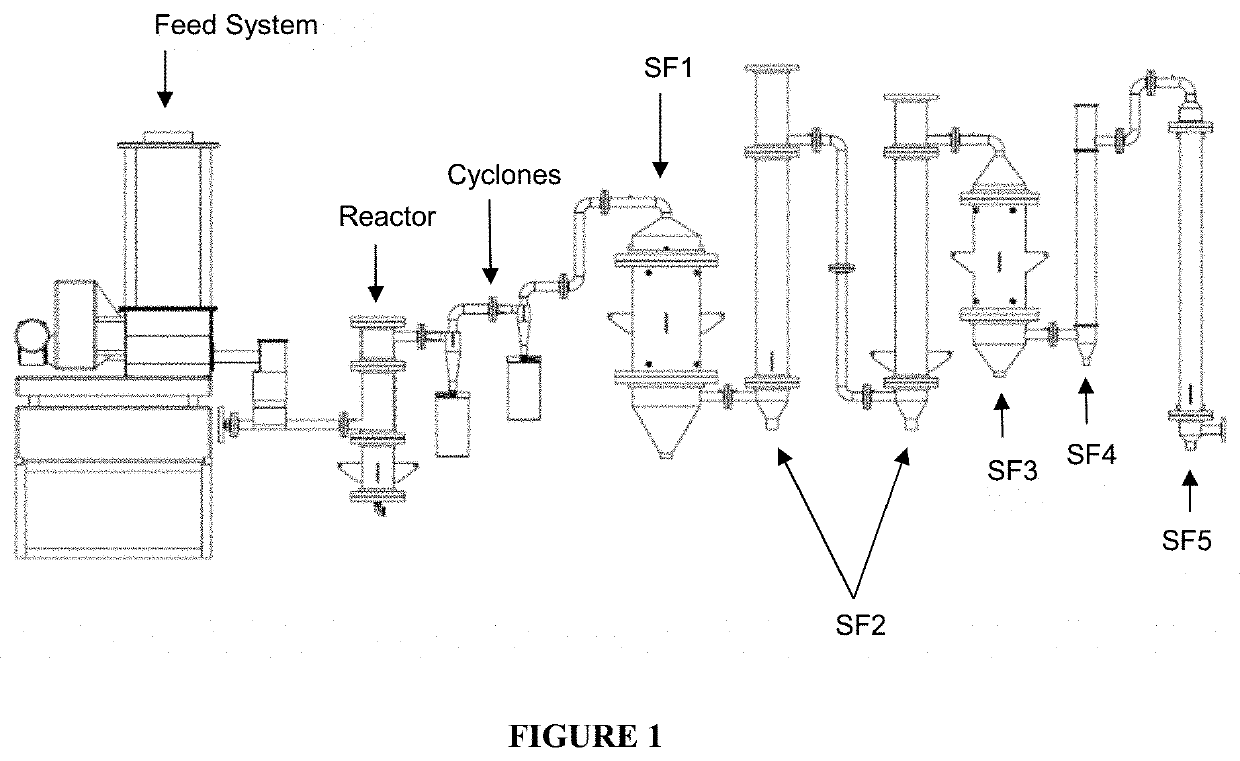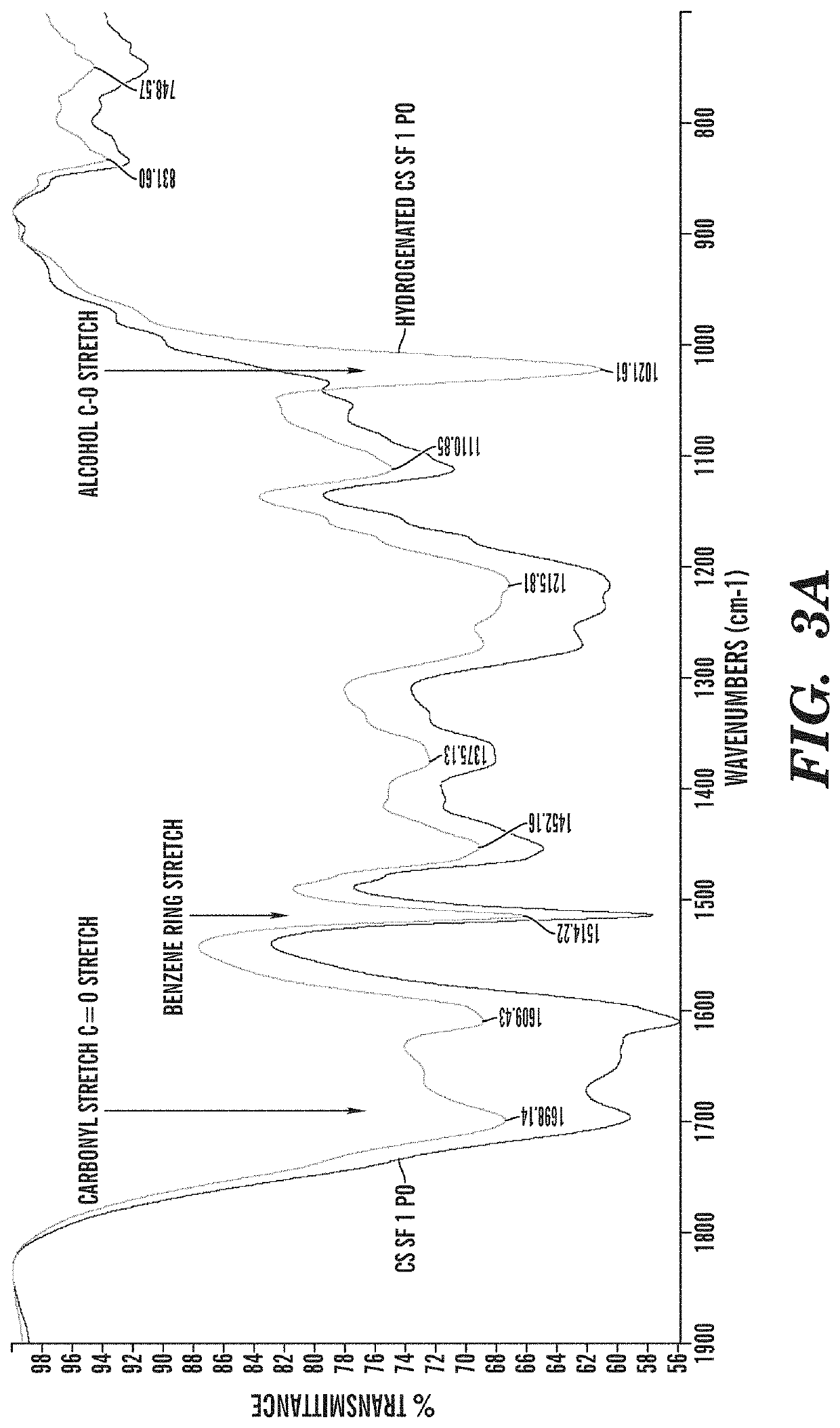Low temperature, low pressure upgrading and stabilization of bio-oil or bio-oil fractions
a bio-oil and low pressure technology, applied in the direction of hydrocarbon preparation catalysts, organic chemistry, chemistry apparatus and processes, etc., can solve the problems of low carbon yield of fuel range molecules and deactivation of hydroprocessing catalysts, and achieve stable bio-oil, reduce viscosity, eliminate polymerization and dehydration reactions
- Summary
- Abstract
- Description
- Claims
- Application Information
AI Technical Summary
Benefits of technology
Problems solved by technology
Method used
Image
Examples
example 1
Hydrogenation of Bio-Oil Under Mild Conditions
Materials and Methods
[0095]Hydrogenation experiments were performed on phenolic oligomers obtained from the heavy ends (higher molecular weight species) of bio-oil collected from condenser and electrostatic precipitator stages of the bio-oil collection system, which are designated respectively as SF1 PO and SF2 PO. The experimental set-up for hydrogenation is shown in FIG. 2.
[0096]The phenolic oligomers from these two stage fractions were produced from corn stover (CS) that had been in cold storage (5° C.) for 6 months and red oak (RO) that was hydrogenated immediately after its production. Biomass was passed through a 60 hp hammer mill equipped with a 3 mm screen, resulting in a particle range of approximately 200 micron to 3 mm.
[0097]Fast pyrolysis was performed utilizing a fluidized bed reactor with a staged bio-oil recovery system (FIG. 1). See, e.g., A. S. Pollard, et al., Journal of Analytical and Applied Pyrolysis, 93: 129-138 (20...
example 2
Zn and HCI Upgrading of Bio-Oil
[0131]The Clemmensen reduction1 was used to upgrade hydrogenated bio-oil SF1 PO, e.g., to remove carbonyl groups. The Clemmensen reduction method is a general methodology in which ketones are converted to the corresponding hydrocarbons with amalgamated zinc and HCl. Modified to operate at much milder conditions (e.g., 0° C. for 1-2 hours), the Clemmensen reduction method reduces a variety of ketones found in whole or fractionated bio-oil (OSHA, ed. U. S. D. o. Labor, Washington, D.C. (2013), which is herein expressly incorporated by reference in its entirety). In this Example, the reaction was slightly modified (as explained below) for use with hydrogenated SF1 PO.
[0132]50 ml ether was added to a flask. The temperature was held at −10 to −15° C. HCl was added dropwise for 45 minutes (10 ml). Hydrogenated SF1 POs (2 g) was added to the ether. Since the hydrogenated SF1 PO was only slightly soluble, 25 ml of methanol was used to rinse the hydrogenated SF...
example 3
Fermentation of Bio-Oil
[0137]Fermentation by Baker's yeast (Saccharomyces cerevisiae) is a mild and inexpensive method to reduce aldehydes and / or ketones (D. Mohan, et al., Energy &Fuels, 20: 848-889 (2006); C. A. Mullen, et al., Energy &Fuels, 23: 2707-2718 (2009), which are herein expressly incorporated by reference in their entirety). Specifically, microbial reduction of carbonyl compounds can be used to upgrade the phenolic oligomers found in bio-oil. Baker's yeast contains oxidoreductase enzymes and co-factors that reduce the substrate (D. Mohan, et al., Energy &Fuels, 20: 848-889 (2006), which is herein expressly incorporated by reference in its entirety). This enzymatic reduction is performed at ambient temperatures and pressure.
[0138]In this Example, the metholodolgy described by R. E. Bozak, et al., Journal of Chemical Education, 68: 427 (1991) was used for both 16 hour and 72 hour Baker's yeast experiments. To begin, 30 g of sucrose was added to 200 ml water and stirred fo...
PUM
| Property | Measurement | Unit |
|---|---|---|
| temperature | aaaaa | aaaaa |
| temperature | aaaaa | aaaaa |
| temperature | aaaaa | aaaaa |
Abstract
Description
Claims
Application Information
 Login to View More
Login to View More - R&D
- Intellectual Property
- Life Sciences
- Materials
- Tech Scout
- Unparalleled Data Quality
- Higher Quality Content
- 60% Fewer Hallucinations
Browse by: Latest US Patents, China's latest patents, Technical Efficacy Thesaurus, Application Domain, Technology Topic, Popular Technical Reports.
© 2025 PatSnap. All rights reserved.Legal|Privacy policy|Modern Slavery Act Transparency Statement|Sitemap|About US| Contact US: help@patsnap.com



